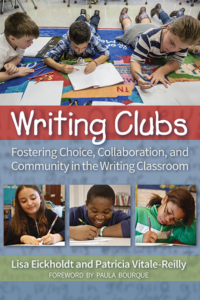The Why and How of Classroom Writing Clubs
Writing Clubs: Fostering Choice, Collaboration, and Community in the Writing Classroom
By Lisa Eickholdt and Patricia Vitale-Reilly
(Stenhouse Publishers, 2022 – Learn more)
Reviewed by Katie Durkin

Creating opportunities for students to read common texts of choice and then discuss them together (and with me!) has always been a cornerstone of the activities I plan for my students each year.

Having students work together on their writing has always looked like peer editing in my classroom. I wanted students to edit each other’s writing to help each other become stronger writers.
But year after year, I felt like peer editing wasn’t working. Some students would finish this work quickly to move on to the next activity, while others spent too much time editing each other’s work, while others didn’t participate in the work at all.
Eickholdt and Vitale-Reilly’s work in Writing Clubs is the solution I have been looking for, and I think any teacher of writing will benefit from their suggestions and thorough information about how to implement these clubs in your own classroom.
Getting Started with Writing Clubs
Dividing the book into three major sections, Eickholdt and Vitale-Reilly begin the first section of Writing Clubs with a brief introduction where they offer readers the purpose and function of writing clubs in the classroom. They describe ideas for how to incorporate writing clubs into different models of learning, such as blended, online, or hybrid learning.
They also provide tips and tricks to guide teachers in launching these clubs in the classroom. This first section introduces the reader to the two major types of clubs discussed in the book, complement and stand-alone clubs, which are the focus of the last two major sections.
Process, Craft and Digital Clubs
The second section of the book focuses on complement clubs, where the authors provide information about three different types of writing clubs that could complement current units of study in the classroom. These three types of clubs will live alongside any unit of study on writing. They include:
1. Process clubs, which are described as students embarking on completing a piece of writing where they will learn how to support and mentor each other through the different stages of their individual writing process.
2. Craft clubs, which focus on the use of mentor texts to teach students about different craft moves authors can make to communicate through their writing.
3. Digital clubs, which allow students to use diverse digital platforms to create pieces of writing. Examples the authors provide include digital poetry, book trailers, videos, public service announcements, or multitouch books with links to websites or audio.
Genre, Author and Convention Clubs
The final section concentrates on stand-alone clubs, where students and teachers will be focused on genre, author, or convention study in clubs that allow students more choice in the classroom when deciding on what they would like to work on in their writing.
1. Genre clubs have students choose a genre they would like to explore in “clubs” (small groups), working with students who will be writing the same type of text. Examples of genre clubs could include graphic novels or comics, reviews, procedural texts, or any type of fiction.
2. Author clubs have students choose any author who they would like to get to know as a writer, reading multiple texts to eventually learn about craft moves to try out themselves as a writer.
3. Convention clubs move beyond just understanding the proper use of punctuation and capitalization in writing, and instead help students think about the “power of conventions” (p. xiii). Personally, this was my favorite club to learn about because students are asked to “experiment and play” with conventions rather than memorize how they have to be used (p. 150).
Convention clubs open up more possibilities for students to see how conventions can be used in fun ways to communicate different ideas in writing.
Options with Complement and Stand-alone Clubs
The last two sections of the book – focusing on complement and stand-alone clubs – are structured in the same way when describing the three complement clubs: process, craft and digital, and the three stand-alone clubs: genre, author, and convention.
When providing information about the six clubs described in this book, the authors use each chapter to first explain how teachers can prepare for the club by outlining what materials they would need and give options for the work teachers and students will do with the club alongside example teaching points. They also describe how club time is used, including examples of how they work with students and their thoughts as they create each club.
Finally, each chapter focusing on the clubs provides a calendar with an example unit where the mini-lesson, writing and conferring activities, club meeting, and wrap-up are provided. These calendars include details about the grade, length of unit, and unit of study.
Embedded within the chapters are student work examples, providing teachers with a look at what work students have produced in the past when participating in these clubs. Some chapters include anecdotes from the classroom or among a team of teachers who facilitated a writing club. I found these anecdotes to be particularly poignant because they provided a real-life look at how these writing clubs work.
Some chapters also include direct quotes from the classroom from both teachers and students when launching or participating in the different writing clubs.
Read a MiddleWeb article by
the co-authors of Writing Clubs
Choice and Collaboration
The authors show, as evident by their title, how writing clubs are an opportunity to allow more choice and collaboration in the classroom. While Writing Clubs focuses primarily on grades three through six, these clubs could easily be implemented in 7th and 8th grade, high school and beyond.
We know that writing is not a solitary activity, even though it often presents itself as a task done alone. Writing Clubs provides teachers with an opportunity to transform the way that students write in their classroom, writing collaboratively with opportunities to understand the power of their own writing, much as adults might do when they attend writing workshops and NWP gatherings.
What I love most about writing clubs is that they are student-centered: students are equal participants in gathering resources, offering ideas for mini-lessons and more as they work with teachers and students to grow their skills as writers.
I highly recommend this book to any teacher who wants to try something new with writing in their classroom. It is a quick read and provides fantastic detail about how you could implement any of these clubs into your classroom.
I even plan on using many of Eickholdt’s and Vitale-Reilly’s ideas with my first-year college students, who will be taking my adjunct class on rhetoric and composition. I am excited to provide my school and college students with a fresh perspective on their own writing and to invite them into building and expanding their writing identities through writing clubs.
Katie Durkin (@kmerz610) has been teaching English Language Arts to middle school students for over a decade, and currently teaches 7th grade Reading Workshop at Middlebrook School in Wilton, Connecticut. She is a zealous reader of middle grade and young adult books and enjoys sharing her love and passion for reading with her students. In 2022 Katie graduated from Northeastern University with her doctorate in education, where her research examined the impact of classroom libraries on middle school students’ reading engagement. She was the 2020 recipient of the Edwyna Wheadon Postgraduate Training Scholarship from the National Council of Teachers of English


































Katie,
Thanks for the thorough review of this book! I happen to run writing clubs and will put this book on my “purchase” list.